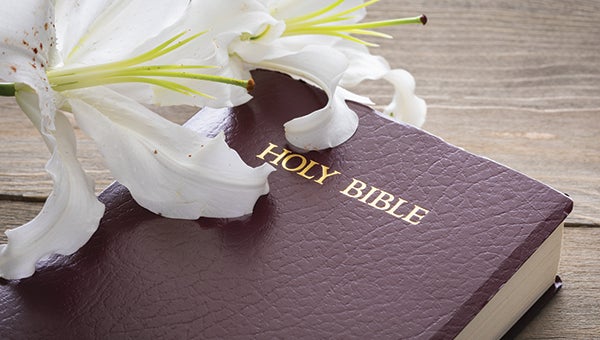Italian-Americans celebrate 39th St. Joseph’s Altar
Published 9:03 am Wednesday, March 20, 2013
After weeks of preparation, the members of the Italian-American Cultural Club presented its annual St. Joseph’s Altar for all to see and enjoy, tohonor St. Joseph on his feast Day, March 19, but celebrated March 16-17.
In Italy, St. Joseph, or San Giuseppe, is revered by the Catholic faithful, as the saint of the poor. The tradition of St. Joseph’s Altars began sometime during the Middle Ages, when, the story is told, that at a time when the region was plagued with drought and famine, Sicilian peasants prayed to St. Joseph for held. When the drought ended, the farmers were so grateful that they threw a party, with a giant feast to honor him answering their prayers.
And so the tradition continues. From the Middle Ages to the 21st Century, Italians — and in America, Italian-Americans — continue to pray to St. Joseph for his help and through the centuries, people who have prayed for a favor that has been granted, celebrate and honor him on his day. It has been said that when praying to St. Joseph one must be careful when he wishes for, and although the “favor” or request cannot involve personal gain or benefit, prayers to St. Joseph can be powerful, according to many who regularly ask for his intercession.
One long-standing tradition on St. Joseph Day is to visit nine different altars throughout the day. In Bogalusa, however, there is just one. Since 1974, the Italian-American Club has displayed its altar, which has grown over the years with the addition of donated and handed down statues for display, as there must always be representations of six saints on the altar, including St. Joseph, St. Lucy, St. Anne, St. Jude, Jesus and Mary, portrayed this year by Bob Ricca, Vita Saltaformaggio, Dianne Brumfield, Leon Puisseguer, Vaughn Gibson and Verna Haik.
Another tradition is the fava bean, or “lucky bean,” which legend has it bestows upon those who carry it an unending supply of coins, or wealth. Once grown just for animal feed, it has now become a staple on the tables of Italians, especially in Sicily.
Creating the altar every year is a huge task, with many hours of work involved beyond the cooking and baking. The physical altar itself must be erected, and then it must be decorated, not only with the fruits of the labor of those baking the goods, but also with the many decorative items handed down over the years, such as the statues of the Saints and other items such as flowers and candles.
Once completed, the altar must be blessed by a priest. Three tiers high, symbolizing the Holy Trinity, the altar features a statue of Saint Joseph at the top, surrounded by flowers and greenery. The other tiers might hold, in addition to the food, flowers (especially lilies), candles, figurines and symbolic breads and pastries shaped like chalices, fishes, doves, etc.; 12 fishes symbolizing the 12 Apostles; wine symbolizing the miracle at Cana; pineapple symbolizing hospitality; lemons for “luck”; bread and wine (symbolizing the Last Supper). There would also be a basket in which to place prayer petitions. It is a belief of many that by having a Saint Joseph Altar good fortune will follow. Stories abound about favors received, such as a loved one’s recovery from illness. Saint Joseph is credited with the loved one’s return to health.
Mary Brignac, a long-standing member of the Italian-American Club, noted that every year the same people have the same tasks to perform. She also said, ““We’re trying to continue the tradition, when so many traditions are falling by the wayside.”
Verna Haik, who has been president of the club for the past decade, said that what most people are unaware of is that the church is not involved in the St. Joseph’s Altar celebration.
“It’s just the Italian-American Club that’s responsible,” she said.
On Friday evening, Fr. Pat Collum was on hand to bless the altar, and after that all those in attendance were treated to pastries and cookies, as well as red or white wine (soda for the kids).
Those unable to come to the celebration the following day were treated to a “goody bag” filled with sweet treats and breads. For the altar, many loaves of bread are baked, some in the shapes of staffs, ladders, hammer and nails to represent Saint Joseph, and as crosses, palms or wreaths (representing the crown of thorns) for Jesus.
But it’s the cookies, those lucious fig cookies especially, that everyone loves; many ask for the recipe. The fig cakes are decorated in many lovely patterns, are large and small, in various shapes and sizes and iced in colors of pink, green, white, yellow and chocolate, and can be flavored with almond, vanilla, lemon, anise and other spices. The Pignolati are pastry kernels molded with caramelized sugar into pyramids, which represent the pinecones Jesus played with as a boy. There are seed cookies, biscotti, anise cookies and sfinges, which are rather like Italian beignets.
In addition to a goody bag, each person in attendance may take home holy cards and a blessed fava bean
The St. Joseph’s Altar is over for this year, but why not try the goody bag full of recipes that follow, many of which were handed down for generations, courtesy of the ladies of the Italian-American Club.
St. Joseph Altar Recipes
Fig Cakes
• 2 pkgs. dried figs
• 1 box diced dates
• 1/2 teaspoon grated orange rind
• 1/2 cup orange juice
• 1 1/2 cups sugar
• 1 teaspoon cinnamon
• 1/2 teaspoon cloves
• 1/2 teaspoon nutmeg
• 2 teaspoons vanilla
• 1 cup pecans
Grind figs, dates and pecans. Place in a large mixing bowl. Add all other ingredients and mix thoroughly. Cover and let stand until needed.
Dough:
• 6 cups all-purpose flour
• 1/2 cup sugar
• 1 teaspoon salt
• 7 heaping tablespoons shortening
• 1 stick butter
• 3 eggs
• 1 1/2 cups cold milk
• 2 teaspoons vanilla
• 4 1/2 teaspoons baking powder
Place all dry ingredients into a large mixing bowl. Cut shortening and butter into dry ingredients. In a separate bowl, beat eggs, milk and vanilla. Add liquid mixture to dry ingredients and mix thoroughly. Dough should be very stiff. Roll out pastry dough into thin square sheets about 12×12 inches square and 1/8 in. thick. Cut dough into strips 3 to 4 inches wide. Place fig filling evenly along the center of the strip. Roll one side of the dough over the top of the filling. Continue to roll dough to complete a long tube of dough and filling. Roll dough with a backward and forward motion to even up the tube and place the overlapping edges on the bottom. Cut into desired shapes.
Place cookies on a lightly greased cookie sheet and bake at 375 degrees for 20-25 minutes or until lightly browned. Remove from oven and place on waxed paper. Allow to cool, then frost with a simple powdered sugar and milk icing. Yields about 100 cookies.
Icing:
• 1 pound powdered sugar, sifted
• Milk or evaporated milk
• 1 tablespoon flavoring
• Food coloring if desired
Add enough milk to powdered sugar to make a glaze. Add flavoring and coloring. Ice cookies by placing cookies by pouring the icing over the cookies until well coated. Makes icing for approximately 100 cookies.
Seed Cookies
(from Faye Haik)
• 3 cups sugar
• 3 sticks butter
• 10 eggs
• 2 tablespoons vanilla
• 2 tablespoons baking powder
• 6 cups flour
• 1 pound sesame seeds
Cream butter and sugar. Add eggs, beating well. Add vanilla and milk.
Mix flour and baking powder, then stir in sugar mixture. Roll out into finger-sized ropes. Cut into 2-inch pieces. Bake on a greased cookie sheet at 375 degrees for 25 minutes or until brown.
Biscotti
• 1 stick butter
• 3/4 cup sugar
• 3 large eggs
• 3 cups all-purpose flour
• 1/2 teaspoon salt
• 3 cups chopped pecans or almonds (optional)
• 2 teaspoons baking powder
Cream butter and sugar. Beat in the eggs, one at a time. In another bowl, combine the flour, baking powder and salt. Combine dry ingredients with butter mixture to form a sticky dough. Add pecans or almonds. Pat dough into two 14 by 4 inch rectangles on a buttered baking sheet. Brush with eggs and bake at 375 degrees for 20 minutes, until golden brown. Cut crosswise into 3/4 inch slices. Bake 5 minutes on each side of the slices. Cool.
Italian Easter Bread
• 3 to 3 1/2 cups all-purpose flour
• 1 package (1/4 ounce) active dry yeast
• 1 teaspoon salt
• 2/3 cups warm mile (120-130 degrees)
• 7 eggs
• 2 tablespoons butter, softened
• 1/2 cup chopped mixed candied fruit
• 1/4 cup chopped blanched almonds
• 1/2 teaspoon aniseed vegetable oil
In a mixing bowl, combine 1cup flour, sugar, yeast and salt. Add milk and butter; beat 2 minutes on medium. Add 2 eggs and 1/2 cup of flour; beat 2 minutes on high. Stir in fruit, nuts and aniseed; mix well. Stir in enough remaining flour to form a soft dough.
Turn onto a lightly floured board and knead until smooth and elastic, 6-8 minutes. Place in a greased bowl, turn once to grease top. Cover and let rise in a warm place until doubled, about an hour. If desired, dye remaining eggs (leave uncooked); lightly rub with oil.
Punch dough down. Divide in half and roll each piece into a 24-inch rope. Loosely twist ropes together. Please on a greased baking sheet and form into a ring. Split ropes and tuck eggs into openings. Cover and let rise about 30 minutes.
Bake at 350 degrees for 3035 minutes or until brown. Remove and cool.
Pasta Milanese
• 3 medium onions, chopped
• 1 Tbsp. olive oil
• 2 (2 oz.) cans anchovies
• 1 (6 oz.) can tomato paste
• 1 (18 oz.) can tomato puree
• 1 (15 oz.) can tomato sauce
• 1/2 cups water
• salt, pepper, and sugar to taste
• 1/2 teaspoon oregano
• 4-5 fresh basil leaves or 1/2 teaspoon dried basil
• 1 small bunch fresh fennel
• 1 can macaroni seasoning with sardines (Pasta Con Sarde available from Italian specialty stores)
• Cooked spaghetti pasta
In a heavy saucepan over medium heat, sauté onions in oil until clear; add anchovies. Fry slowly. Add tomato paste, tomato puree, tomato sauce, water, salt, pepper, sugar, oregano, and basil. Wash fennel and chop finely; add to sauce. Simmer uncovered on low to moderate heat for 1 hour. Add undrained can of macaroni seasoning with sardines. Cover and continue cooking over moderate heat another hour until thick.
Serve over pasta.






